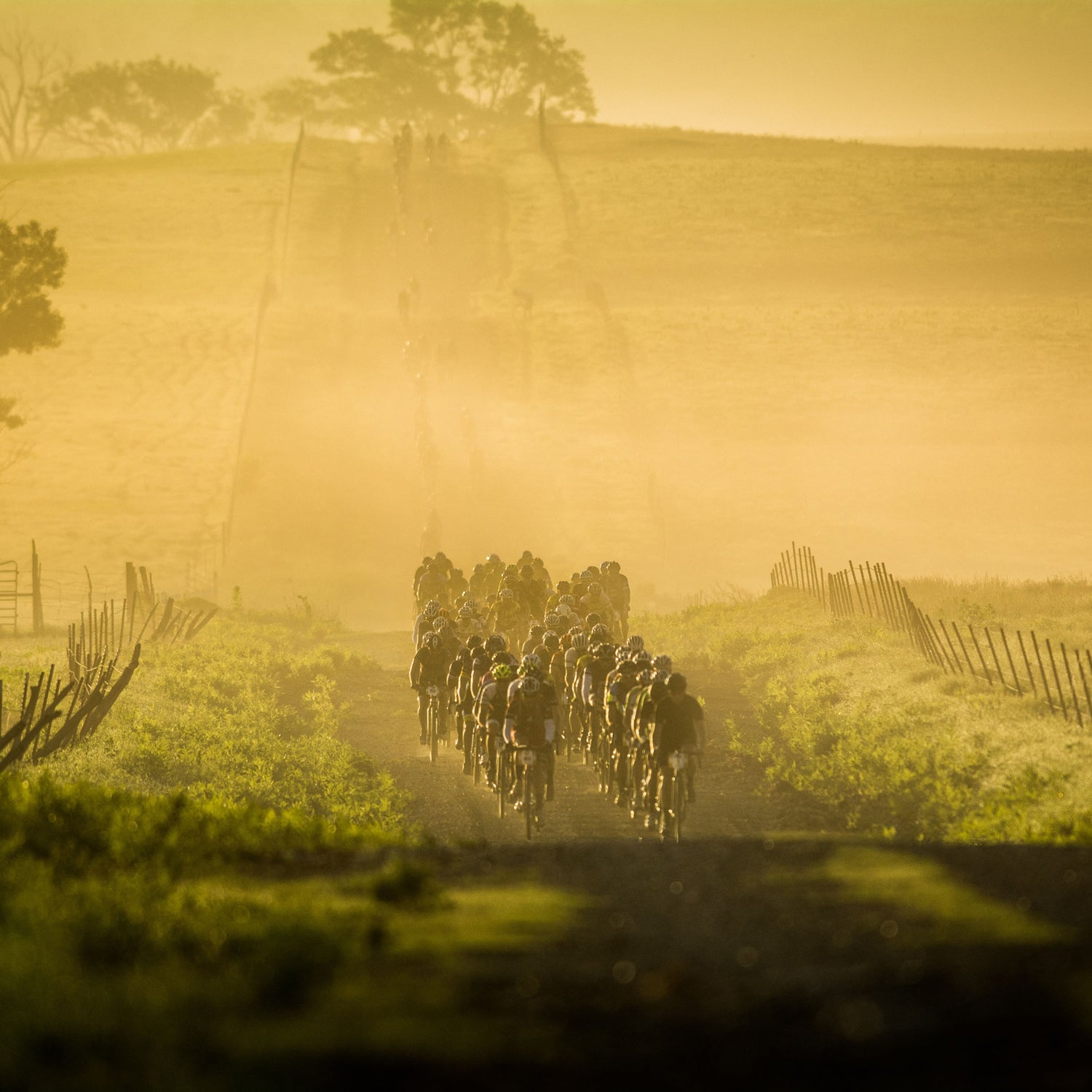In 2015, (USAC) would be organizing a gravel series:
“The gravel segment is the Wild West of bike racing, and it really needs us right now,” said USA Cycling’s CEO, Steve Johnson. “Promoters and bike companies throw around the term ‘gravel’ loosely, racers don’t know what to expect when they see such a term, and there’s no formal regulation on equipment, categories, call-ups or upgrades. Too many people are showing up to events, thinking they can just use standard cyclocross equipment, which is often inappropriate, and sometimes downright dangerous. We’re going to change that in 2016.”
OK, so that was an April Fools gag. However, it contained enough pebbles of truth and prescience that the average reader may not have realized it was satire. Given the exploding popularity of riding bikes fast on tiny rocks, USAC is understandably intrigued by the gravel phenomenon. This past January, the national governing body held a “gravel racing symposium” in Bentonville, Arkansas. “People are registering to do these events in droves,” director of development Tim Johnson told VeloNews about the event. “Gravel is on the tip of everyone’s tongue.”
Gravel on the tongue notwithstanding (pro tip: licking the gravel is a great way to decide which tire tread you should run), droves of registrants are precisely what USAC covets, as its membership has been stagnant for years. It used to be that “bike racing” meant racing in USAC-sanctioned events, which meant becoming a member, getting a license, and working your way through a hierarchy of categories—Novice (formerly Cat 5) being the lowest and Cat 1 being the highest—primarily by earning upgrade points through race results. It’s your category that determines which field you’re eligible to race in at specific events, and while this system helps keep similarly skilled competitors together, and enables USAC to identify national-team talent at the elite level; it’s also a highly regimented process that is not exactly user-friendly (thought USAC has recently ), nor does it do much to accommodate riders who just want to race from time to time for fun. That’s why, increasingly, riders looking for challenge and entertainment in equal measure are opting to participate in a wide variety of independently organized rides and races that operate outside the auspices of USAC, from gran fondos to to gravel races.��
USAC’s interest in gravel seems to be part of a greater effort to address its stodginess factor. Recruiting cyclocross legend and noted gravel-crusher ��in 2018 was one bold step. Furthermore, last year, USAC hired , as its president and CEO. Certainly if DeMartini could transform New Balance from a tired brand of dad shoes to a hip and coveted brand of dad shoes, he could do the same for USA Cycling, an organization that has long been associated with the three M’s of bike racing: Monied Male Masters. , 84 percent of USAC’s membership is male, 40 percent is between the ages of 45 and 64, and according to survey, nearly half had an annual household income of over $100,000. Basically, if you were to draw a Venn diagram of USAC members and Mazda Miata owners, the two circles would overlap like a pair of wheels in a Cat 5 race.����
Gravel, meanwhile, appears to be at least somewhat more diverse, at least in terms of gender. The Dirty Kanza 200, arguably gravel’s marquis event, had . And while that may only be marginally better than USAC’s female participation, the shorter Dirty Kanza 25 managed to not only close the gender gap but invert it, with 55 percent female ridership. More importantly, female participation in gravel appears to be growing. In 2019, Cyclocross Magazine six gravel events and found an overall trend of increasing female ridership across the board. Agewise, however, gravel riders also seem to —which could indicate that gravel is eating USAC’s lunch while simultaneously creating a more welcoming environment for other types of riders.��
Understandably, gravel race promoters aren’t exactly falling over themselves for USAC to sanction their burgeoning events by officiating or overseeing upgrade points. Nor does USAC appear to have any serious designs to play those roles at gravel events, either. According to Rooted Vermont race co-director Laura King, who was at the gravel symposium, USAC simply wants to “to deliver a value to the USAC membership and license holders.” And as Johnson puts it, “If I were a young rider, I’d be wanting to ride my bike in events just like these. At USAC, we have a renewed sense of servicing the community, and gravel definitely fits into that.” In short, it remains to be seen how USAC plans to get involved.
It would appear that USA Cycling needs gravel way more than gravel needs USA Cycling. While gravel may seem like an increasingly vast quarry from which USAC could potentially extract new members, it’s less clear what these riders would have to gain by joining. 2019 Dirty Kanza winner and fixed-gear crit racing star Colin Strickland exemplifies where American bike racing seems to be heading, in favor of racing gravel events like SBT GRVL and Dirty Kanza instead. “I began looking at the [cycling] landscape from an entrepreneurial aspect,” he told , his sponsor. “How can I improve my odds of winning and ensure that those wins would be marketable? This meant following the bike where the road goes, and right now the road is changing from tarmac to gravel.”��
Of course, Strickland is also a . Most elite-level races (especially road and track) are still USAC-sanctioned. But what about the vast majority of riders who are doing this for fun in their spare time and don’t care about sponsorship? If your entrée into competitive cycling is the ebullient world of gravel, why would you then subject yourself to the indignity of the USAC category system?����
None of this is to say USAC will ever be irrelevant. The national governing body’s true primary goal is to develop young riders into American talent that can compete on the world stage, and we’ll always have aspiring national champions and juniors dreaming of whatever the 21st century equivalent of the Wheaties box is (in addition to amateur road racers with jobs and families who are willing to take unreasonable risks for $20 primes and free energy drink samples). But in order to mint those future champions, USAC needs a “” it says it doesn’t have the money to build. Meanwhile, it’s also presiding over competitive cycling in a country where fewer kids are riding bikes every year, and where even people obsessed with the sport can have a really hard time getting their kids involved. Consequently, American bike racing is still the domain of middle-aged people with means, and these people can now get their competitive jollies from the cooler and less formal gravel scene, resulting in a moderately more diverse cross-section of middle-aged hobbyists. That’s the real crisis for USAC, and cycling as a whole.
In light of this, it’s hard to care too much about USAC’s relationship with gravel, because no matter what happens there will always be event organizers ready to serve the competitive needs of the over-40 set, and the idea that capturing a larger market share of this fickle demographic will ultimately trickle down to younger riders feels mostly like a matter of faith. Furthermore, as a USAC member and parent myself, most gravel events may as well be on the other side of the earth, and I’m far less interested in expensive epics that require lots of travel than I am in regular, accessible events close to home that I can integrate into my everyday routine. More importantly, I’d like to get my kids participating one day, and while the growing popularity of the Crusher in the Tushar doesn’t help me with any of this, I sure do wish there was a BMX track within striking distance of my home. (If USAC were to pitch in on local bike advocacy efforts that certainly wouldn’t hurt either.) As a potential pipeline, an organization like the seems a lot more compelling than gravel.
As awesome and successful as these gravel races are, maybe they’re exactly the wrong model for diverse, multigenerational competitive cycling to flourish. Ultimately a handful of popular events are still a less valuable resource than thousands of tiny local ones. Sure, it’s important for USAC to keep on top of what’s cool in riding bikes, but hopefully they don’t miss the forest for the gravel.


